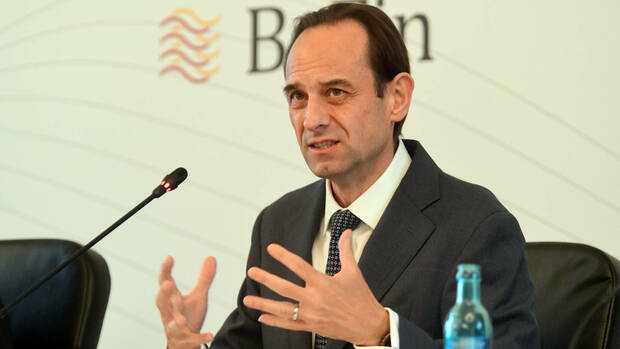“Double vulnerability in the system”: Customers park their savings for a shorter period of time and, thanks to the digitization of the banking business, can also withdraw them more quickly, Branson warns.
(Photo: IMAGO/sepp spiegl)
Frankfurt After the collapse of Credit Suisse and several US banks such as Silicon Valley Bank, the financial regulator Bafin is considering tougher liquidity requirements for European credit institutions. The most recent difficulties have shown that companies and private investors withdraw deposits in crisis situations much faster than in the past, said Bafin boss Mark Branson on Wednesday at a Bundesbank conference.
The reasons for this are digitization, social media and also the accelerated transmission of information through traditional media. Banks actually have to hold sufficient liquidity reserves for crisis situations.
However, the increased speed of deposit outflows in crisis situations is not sufficiently taken into account in the models that banks and regulators use to calculate the necessary size of these liquidity buffers, said Branson.
The reason for this: during the financial crisis of 2008, customers’ savings deposits proved to be a particularly stable source of financing. That is why the bank supervisors are demanding smaller liquidity cushions from financial institutions that are primarily financed by deposits. In the case of the Silicon Valley Bank, customers had withdrawn enormous amounts of deposits within a very short time, raising doubts about the fundamental superiority of customer deposits.
More sight deposits
There is also another factor: in the many years of the past low-interest phase, numerous bank customers have shifted their savings into sight deposits such as overnight money, from which they can withdraw their savings immediately. The proportion of long-term fixed-term deposits fell significantly over the same period because the interest rates on them were hardly higher.
According to Branson, the proportion of such sight deposits is now 70 percent, which customers could withdraw at any time. There is therefore a “double vulnerability in the system: a higher rate of outflows and many more sight deposits than in the past,” warned the Bafin boss.
After the bank earthquake in the spring, financial supervisors worldwide are discussing revising the calculation of liquidity ratios. However, it will likely take years for new rules to be agreed and implemented at global level.
That’s why the financial regulators in Germany and at the European level are examining whether they are demanding larger liquidity buffers from institutions with a “particularly vulnerable profile,” said Branson. The focus is not on savings banks and cooperative banks, but on asset managers and “larger banks with larger capital market refinancing”.
When banks have large amounts of money from wealthy customers or companies whose deposits are not protected, the risk that they will withdraw their funds in a crisis is particularly high. In addition, banks are considered at risk that focus primarily on the management of deposits and otherwise do little active business with customers, such as managing their accounts or granting loans.
In the private customer business, banks can reduce their liquidity risks by offering attractive fixed-term deposits where customers invest their money for a year or two. Currently, however, direct banks in particular are more likely to attract new customers with lure offers for overnight money.
More: ING attracts new customers with 3.5 percent interest
